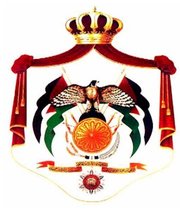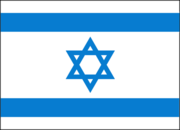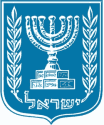Israel-Jordan Treaty of Peace
|
|
The Israel-Jordan Treaty of Peace, or Israel-Jordan peace treaty, full name: Treaty of Peace Between the State Of Israel and the Hashemite Kingdom of Jordan, is a peace treaty signed between the State of Israel and the Hashemite Kingdom of Jordan in 1994. The treaty normalized relations between the two countries and resolved territorial disputes between them. Its signing is also closely linked with the efforts to create peace between Israel and the Palestine Liberation Organization representing the Palestinian Authority.
It was signed at the southern border crossing of Wadi Araba on October 26, 1994, and made Jordan only the second Arab country (after Egypt) to normalize relations with Israel.




Background to negotiations
The relationship between Jewish leaders in Palestine and the Hashemite dynasty in the area was characterized by ambivalence as both party's prominence grewin the area. Jordan consistently subscribed to the anti-Zionist policy of the Arab world, but made specific decisions in keeping with a pragmatic point of view.
Several factors are cited for their relative pragmatism towards Israel: Their close geographic proximity, King Hussein's pro-Western orientation and modest territorial aspirations, and Israel's continuing efforts to establish lasting peace with its neighbors.
Nevertheless, a state of war existed between the two countries from 1948 until the treaty was signed.
Memoir writers and political analysts have identified a number of "back-channel" and at times clandestine communications between the two countries, often resulting in limited accommodations even during times of war.
After the Fedayeen attacks from Jordan decreased as a result of the victory of Israel in the Suez War of 1956, the tense relations between Israel and Jordan following the 1948 Arab-Israeli war started to ease off. In 1967, Jordan attacked Israel despite an Israeli warning not to do so. This resulted in the fall of East Jerusalem and the West Bank to Israel. In 1970 King Hussein waged the war of Black September against the PLO, ejecting the organization. Jordan did not take part in the Yom Kippur War in 1973.
The war against the PLO terrorist factions may have strengthened the connections between Israel and Jordan. Some claim that the Mossad gave warning to Hussein about a Palestinian assassination attempt, and some claim that Hussein warned Israeli Prime Minister Golda Meir about Egyptian and Syrian threats prior to the Yom Kippur War.
In 1988 there was a proposal for a peace agreement with Jordan in which Israel would give Jordan most of the West Bank, but it wasn't consummated. During that year, Jordan abandoned its claim for the West Bank in favor of a peaceful resolution between Israel and the PLO.
The negotiation of the agreement
During 1994 the ice was broken. Israeli Prime Minister Yitzhak Rabin and Foreign Minister Shimon Peres informed King Hussein that after the Oslo Accords with the PLO, Jordan may be "left out of the game". Hussein consulted with the Egyptian President Hosni Mubarak and the Syrian President Hafez al-Assad. Mubarak encouraged him, but Assad told him only to "talk" with Israel and not sign any accord. US President Bill Clinton pressured Hussein to start peace negotiations and to sign a peace treaty with Israel and promised him that Jordan's debts would be forgiven. The efforts succeeded and Jordan signed a nonbelligerency agreement with Israel. Rabin, Hussein and Clinton signed the Washington Declaration in Washington, DC, on July 25, 1994. The Declaration says that Israel and Jordan would end the official state of enmity and would start negotiations in order to achieve an "end to bloodshed and sorrow" and a just and lasting peace. [1] (http://www.mfa.gov.il/MFA/Peace+Process/Guide+to+the+Peace+Process/The+Washington+Declaration.htm)
Negotiations started soon after the Washington Declaration. The main points of the dispute were a 400 square-kilometer area in the Arava, which Jordan claimed Israel annexed over the years, and the dividing of the water resources of the Jordan River - which is water flowing from the Sea of Galilee and held in the Degania dam and diverted to the National Water Carrier. Eventually, these problems were solved when Israel agreed to hand back most of the territory to Jordan and give it 50 millions cubes of water each year.
The signing of the agreement
On July 1994 the Prime Minister of Jordan Abdelsalam al-Majali declared an "end to the age of wars" and Shimon Peres declared that "the moment of peace has arrived". Rabin and King Hussein held a public meeting with Clinton at the White House.
On October 26, 1994 Jordan and Israel then signed the historic peace treaty in a ceremony held in the Arava valley of Israel, north to Eilat and near the Jordanian border. Prime Minister Rabin and Prime Minister Abdelsalam al-Majali signed the treaty and the President of Israel Ezer Weizman shook hands with King Hussein. It was witnessed by President Bill Clinton, accompanied by US Secretary of State Warren Christopher. Thousand of colorful balloons released into the sky ended the event.
The Israeli public fully supported the agreement and was very excited about such an historic moment. Egypt welcomed the agreement and Syria ignored it. However, the Lebanese terrorist group Hizbullah resisted the treaty and 20 minutes prior to the signature ceremony shelled the northern Galilee settlements with mortar shells and rockets. The Israeli residents, who were forced to evacuate into shelters, took with them radio transistors and mobile TVs in order not to miss the historical moment of signing a second peace treaty with an Arab state.
Following the agreements, Israel and Jordan opened their borders as borders of peace. Several border-crossings were erected across the border, allowing tourists, merchants and workers to travel between the two states. Israeli tourists started to visit Jordan, many of them traveled especially to see the sela ha'adom ("Red Rock") of Petra - a stone-carved Nabatean city which fascinated Israelis during the 50's and the 60's, often luring adventurers to visit it secretly.
Trade treaty of 1996
On 1996 an additional trade treaty was signed and Israel provided a lot of help in establishment of a modern medical center in Amman.
Main principles in the agreement
- Borders: the agreed upon border was set to be the Jordan river, and if its flow changed, the border would be reset by the Jordan river's course. In addition, Israel gave Jordan 300 squar-kilometers and leased 2850 dunams in the Arava (Muvlaat Tzofar). The border segment from Ein Gedi to Beit She'an was not marked, because Jordan said that the Palestinian Authority should be a partner for setting this border.
- Normalization: full normalization, establishment of diplomatic relations and opening embassies, granting tourists visas, opening a flight connection, freedom of access to seaports and the establishment of a free trade zone and an industrial park in the Arava. In the framework of good neighborliness, there is a prohibitation of hostile propaganda and negative expression in the countries' laws.
- Security and Defense: respect for the sovreignty and territory of each side, not entering without permission, cooperation against terror and joint counter-terror efforts; including thwarting border attacks and smugglers, each is country obliged to prevent any hostile attack against the other and not to cooperate with terrorist organization against the other.
- Jerusalem: Jordan will be given preference when it comes to the status of the Muslim holy place in the city (as a guardian or keeper of the Muslim holy places) in any future peace agreement with the Palestinians.
- Water: in the framework of a just division of the water of the Jordan River and the Arava's underground water resources, Israel agreed to give Jordam 50 million cubes of water each year (Jordan demanded 100 miilion) and to share the Yarmouk River so that Jordan has 3/4 of it. Both countries will develop other water resources and reservoirs and will help each other in years of drought.
- Palestinian refugees: Israel and Jordan will cooperate in order to relieve the suffering of the refugees, including a four-way committee (Israel, Jordan, Egypt and the Palestinians) which will try to work towards a solution.
The treaty
The treaty consists of a preamble, thirty articles, five annexes, and agreed minutes.
Preamble of the treaty: Desire for peace
Israel and Jordan note and agree to honor the Washington Declaration, signed July 25, 1994, and basing themselves on UN Security Council Resolution 242 and 338 in all aspects, they declared the termination of the state of belligerency between them and establish peace between them in accordance with the treaty of peace.
Articles of the treaty
The following is a synopsis of the treaty's thirty articles:
Article 1: Peace established
Peace is established between the State of Israel and the Hashemite Kingdom of Jordan.
Article 2: Mutual recognition
Recognise and respect each other's sovereignty, territorial integrity and political independence.
Article 3: Borders
Deliniation and recognition of the international boundary between Israel and Jordan wass delimited with reference to the boundary definition under the Mandate.
Article 4: Security cooperation
Mutual understanding and co-operation in security-related matters would form a significant part of relations. They recognized the achievements of the European Union in developing the Conference on Security and Co-operation in Europe (CSCE) and commited themselves to the creation, in the Middle East, of a CSCME (Conference on Security and Co-operation in the Middle East). And to refrain from the threat or use of force or weapons, conventional, non-conventional or of any other kind, and combating terrorism of all kinds.
Article 5: Diplomatic relations
Establishing full diplomatic and consular relations and to exchange resident ambassadors, including normalization of economic and cultural relations.
Article 6: Water resources
Recognizing the rightful water allocations of both of them in the Jordan River and Yarmouk River waters and Arava ground water and development of new water resources.
Article 7: Economic cooperation
To promote economic cooperation by to removing discriminatory barriers and terminate economic boycotts.
Article 8: Refugees
The problem of displaced persons would also be discuused with together with Egypt and the Palestinians, and the problem of refugees would be discussed in multilateral manner in conjunction with and at the same time as the permanent status negotiations pertaining to the territories.
Article 9: Holy places
Freedom of access to places of religious and historical significance. Israel would respect the special role of the Hashemite Kingdom of Jordan in Muslim Holy shrines in Jerusalem. When negotiations on the permanent status will take place, Israel will give high priority to the Jordanian historic role in these shrines.
Article 10: Culture ans science
Establishing cultural and scientific exchanges in all fields, and agree to establish normal cultural relations.
Article 11: Stop propaganda
To abstain from hostile or discriminatory propaganda against each other and to repeal all adverse or discriminatory references and expressions of hostility in their respective legislation.
Article 12: Drugs and crime
To combat crime, smuggling, trafficking in illicit drugs, and will bring to trial the perpetrators.
Article 13: Roads
Permitting the free movement of people and vehicles and not to impose discriminatory taxes or restrictions. To open and maintain roads and border-crossings, and agreed to continue negotiations for a highway to be constructed between Egypt, Israel and Jordan near Eilat.
Article 14: Freedom of the sea
Right of passage through territorial waters in accordance with the rules of international law with normal access to ports.The Strait of Tiran and the Gulf of Aqaba are to be international waterways open to all nations.
Article 15: Air travel
Recognition of the rights, privileges and obligations provided for by the multilateral aviation agreements, particularly of the 1944 Convention on International Civil Aviation (The Chicago Convention) and the 1944 International Air Services Transit Agreement.
Article 16: Communications
Having direct telephone and facsimile lines and postal links.
Article 17: Tourism
Promoting co-operation in the field of tourism.
Article 18: Environment
Cooperating relating to the environment, conservation of nature and prevention of pollution.
Article 19: Energy
Development of energy resources and projects such as the utilisation of solar energy. Interconnecting of the electric grids in the Eilat-Aqaba area.
Article 20: Rift Valley
Development of the Jordan Rift Valley area, including joint projects in the economic, environmental, energy-related and tourism fields.
Article 21: Health
Cooperation in the area of health.
Article 22: Agriculture
Cooperation in the areas of agriculture, including veterinary services, plant protection, biotechnology and marketing.
Article 23: Aqaba-Eilat
Arrangements for the joint development of the towns of Aqaba and Eilat, such as tourism development, customs, free trade zone, aviation, prevention of pollution, maritime matters, police, customs and health co-operation.
Article 24: Claims commission
Establish a claims commission for the mutual settlement of all financial claims.
Article 25: Obligations
The treaty would not affect their rights and obligations under the United Nations Charter, to fulfil in good faith their obligations and to abolish all pejorative references to each other.
Article 26: Legislation
To enact the legislation necessary in order to implement the treaty, and to terminate any international commitments and to repeal any legislation that is inconsistent with it.
Article 27: Ratification
The treaty would be ratified by both countries in conformity with their respective national procedures.
Article 28: Interim measures
Application of interim measures.
Article 29: Dispute resolution
Disputes arising out of the application or interpretation of the treaty should be resolved by negotiations. Any such disputes which cannot be settled by negotiations should be resolved by conciliation or submitted to arbitration.
Article 30: Registration with UN
The treaty would be transmitted to the Secretary General of the United Nations for registration in accordance with the provisions of Article 102 of the Charter of the United Nations.
Annexes of the treaty
Annex 1: Borders
See: Israel-Jordan Peace Treaty, Annex I, Israel-Jordan International Boundary Delimitation and Demarcation [2] (http://www.jewishvirtuallibrary.org/jsource/Peace/annex1.html)
Annex 2: Water
See: Israel-Jordan Peace Treaty, Annex II, Water Related Matters [3] (http://www.jewishvirtuallibrary.org/jsource/Peace/annex2.html)
Annex 3: Crime and drugs
See: Israel-Jordan Peace Treaty, Annex III, Combatting Crime and Drugs [4] (http://www.jewishvirtuallibrary.org/jsource/Peace/annex3.html)
Annex 4: Environment
See: Israel-Jordan Peace Treaty, Annex IV, Environment [5] (http://www.jewishvirtuallibrary.org/jsource/Peace/annex4.html)
Annex 5: Interim measures
See: Israel-Jordan Peace Treaty, Annex V, Interim Measures, Border Crossing Points Procedures Between Israel and Jordan [6] (http://www.jewishvirtuallibrary.org/jsource/Peace/annex5.html)
Agreed minutes of the treaty
See: Israel-Jordan Peace Treaty, Agreed Minutes [7] (http://www.jewishvirtuallibrary.org/jsource/Peace/agmins.html)
See also
- Arab-Israeli conflict
- Itzhak Rabin
- King Hussein of Jordan
- Shimon Peres
- Bill Clinton
- Elyakim Rubinstein
Arab-Israeli peace diplomacy and treaties
- Paris Peace Conference, 1919
- Faisal-Weizmann Agreement (1919)
- 1949 Armistice Agreements
- Camp David Accords (1978)
- Israel-Egypt Peace Treaty (1979)
- Madrid Conference of 1991
- Oslo Accords (1993)
- Israel-Jordan Treaty of Peace (1994)
- Camp David 2000 Summit
- Peace process in the Israeli-Palestinian conflict
- Projects working for peace among Israelis and Arabs
- List of Middle East peace proposals
- International law and the Arab-Israeli conflict
External links
- Text of the Treaty (http://www.kinghussein.gov.jo/peacetreaty.html), at the site of King Hussein of Jordan
- Text of the Treaty (http://www.mfa.gov.il/mfa/go.asp?MFAH00pa0), at the site of the Israeli Ministry of Foreign Affairs
- The Washingtom Declaration (http://www.mfa.gov.il/MFA/Peace+Process/Guide+to+the+Peace+Process/The+Washington+Declaration.htm), at the site of the Israeli Ministry of Foreign Affairshe:הסכם השלום בין ישראל לירדן
